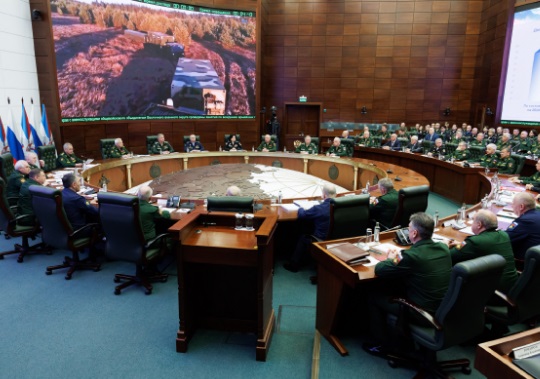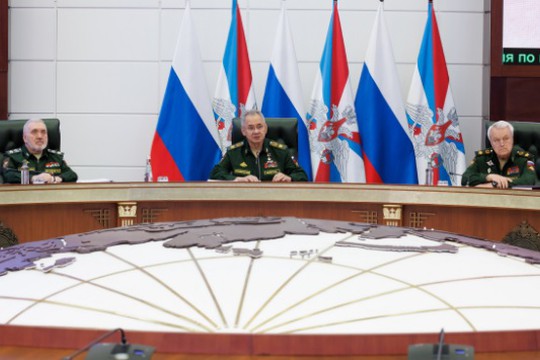Photo: MoD Department for Media Affairs and Information
Russian Defence Minister General of the Army Sergei Shoigu holds a Defence Ministry Board session at the National Centre for State Defence Control.
Opening the session, the Russian Defence Minister briefed the attendees on the progress of the special military operation.
'The Russian Groups of Forces hold the initiative along the entire line of contact and continue to push the enemy out of the line of contact. Russian servicemen have liberated Pervomayskoye, Bogdanovka, and Novomikhailovka (Donetsk People's Republic) as a result of active combat operations. The control zone is being extended in Berdychi and Georgiyevka,' Sergei Shoigu said.
He also added that our high combat potential allowed Russia to constantly inflict fire damage on the enemy and prevent the adversary from holding the line of defence.
'Washington is going to allocate almost $61 billion to the Kiev regime to prevent the Armed Forces of Ukraine (AFU) from failure. Most of the funding will go to the U.S. defence industry. The U.S. authorities cynically claim that Ukrainians will die for their interests in the fight against the Russian Federation,' the Russian Defence Minister noted.
According to the Russian Defence Minister, since the beginning of the special military operation, the AFU has suffered losses of almost half a million troops.
'Kiev regime failed to achieve its objectives in the counter-offensive prepared by the NATO instructors. Russian servicemen defused the myth of the Western weapons' superiority,' Sergei Shoigu said.
The enterprises of the Russian defence industry have increased their capabilities. The Russian Armed Forces have significantly enhanced the combat potential. It is proved by the situation in the special military operation zone.
'Russia will continue to improve the composition and structure of the armed forces and increase the production of the most in-demand weapons and military hardware in proportion to the threats posed by the United States and its allies. We shall increase the intensity of strikes against logistics centres and storage facilities of the Western armament. The Armed Forces of the Russian Federation will continue to carry out the tasks until the special military operation's objectives are fully achieved', the Russian Defence Minister stated.

* * *
The head of the military department then discussed the involvement of the Armed Forces in flood relief operation.
Since March, military personnel have been involved in flood control measures on rivers in Bashkiria and Buryatia, Transbaikal and Khabarovsk regions, and Ulyanovsk and Chelyabinsk regions, and have ensured the unimpeded passage of ice in several sectors of the rivers.
Efforts are still underway to stabilise the flood situation in Orenburg and Tyumen regions and to deal with the consequences of high water levels of the Ural and Ishim rivers.
Work in this area is still underway.
* * *
Moving on to the thematic agenda of the session, Sergei Shoigu proposed to discuss the state and prospects for the development of air defence and anti-missile defence troops.
'In total, more than 22,000 drones and about 6,000 projectiles, to include HIMARS 3,549 and Vampire 361 projectiles, as well as about 2,000 other aerial targets, to include 592 warplanes, 270 helicopters, 349 anti-aircraft guided and tactical ballistic missiles, 329 guided missiles, 278 anti-radiation missiles, and 37 air balloons have been eliminated since the beginning of combat operations.
Regional authorities in Moscow, the regions of Moscow, Leningrad, and Belgorod, and Krasnodar province make a significant contribution to increasing the effectiveness of the air defence system. With their support, units are formed to counter unmanned aerial vehicles, and positions are equipped for anti-aircraft missile and radio-technical troops.
One of the priorities for the development of the Aerospace Forces is to equip the Air Defence and Anti-Missile Defence forces with promising weapons. Today, the proportion of modern samples has reached 82%, and this figure needs to be increased to 85% in the next two years,' Sergei Shoigu stressed.
This year the troops are going to receive:
- the first samples of a new generation S-500 anti-aircraft missile system in two modifications: long-range anti-aircraft missile systems and anti-missile defence systems;
- S-400, S-300V4, Buk-M3, and Tor-M2U anti-aircraft missile systems;
- new-generation radar stations.
'The Pantsir anti-aircraft missile systems have proved to be successful. This year we will almost double their supply,' General of the Army Sergei Shoigu added.
Improvement of air defence and anti-aircraft missile defence systems will provide high-quality cover for the most important objects of the command and control system, strategic nuclear forces, and groups of forces.

* * *
The participants of the Board's session next discussed work towards the formation of the Leningrad and Moscow military districts.
'Military and political tensions increased in the western and north-western strategic directions following Sweden's joining the North Atlantic Alliance in early March. Today, the NATO troop reinforcement has up to 33,000 military personnel, about 300 tanks, and more than 800 other armoured fighting vehicles at the Russian borders,' Sergei Shoigu said.
The Headquarters of the Security Assistance Group-Ukraine is deployed on the basis of the United States European Command in Germany.
A series of exercises of the NATO forces are taking place right now. Up to 90,000 troops are involved in them training to repel Russia's allegedly prepared aggression.
The Alliance is trying to increase activity in the Arctic.
'Such actions by Western countries are forcing us to apply adequate response measures,' Sergei Shoigu stated.
He recalled that in 2022 the Supreme Commander-in-Chief decided to transform the Western Military District into Leningrad and Moscow military districts. Since 1 March, they have received all the relevant instructions and have started operation.
The formation of the Leningrad Military District involved more than 250 events. The 44th Army Corps has been established. Three motorised rifle brigades will be reformed into motorised rifle divisions.
This year's organisational events are synchronised with the supply of more than 7,000 units of weapons and military equipment.
The Moscow Military District has held more than 400 organisational events. Another ten events will have been completed by the end of the year. The troops will receive more than 2,400 pieces of modern weapons and equipment.
The training level of military personnel and command and control bodies is being improved in these units. The experience gained during the special military operation is being put into practice.
Particular attention is paid to training military personnel to effectively use unmanned aerial vehicles. The drills are supervised by combat instructors.
'We shall continue to build up the capacity of the districts in accordance with the Ministry of Defence's Activity Plan,' the Russian Defence Minister concluded.
read more in our Telegram-channel https://t.me/The_International_Affairs

 17:29 23.04.2024 •
17:29 23.04.2024 •























